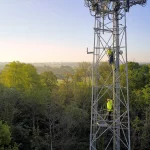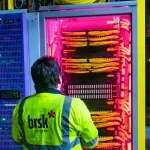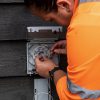Starlink Refresh UK Biz Broadband Plans, But Adds 1Mbps Speed Cap

SpaceX’s Starlink service, which offers ultrafast broadband speeds via a mega constellation of satellites in Low Earth Orbit (LEO), has this week refreshed their range of plans for business customers and made them more affordable for those with lower data usage requirements. But there’s a nasty catch for some customers in the form of a 1Mbps speed cap.
At present Starlink has over 7,100 satellites in Low Earth Orbit (c.3,300 are v2 Mini / GEN 2A) – mostly at altitudes of c.500-600km – and they’re in the process of adding thousands more by the end of 2027. Residential customers in the UK typically pay from £75 a month for a 30-day term, plus £299 for hardware on the ‘Standard’ unlimited data plan (inc. £19 postage), which promises latency times of 25-60ms, downloads of 25-100Mbps and uploads of 5-10Mbps.
However, Starlink also offers a range of plans for business customers too, which have just been refreshed (credits to PC Mag) and reorganised around whether you want to take a “local” or “global” priority service. On the surface, there’s now a much cheaper entry-level tier for business users with only basic needs (i.e. £39 +vat per month for 50GB of data), which is good. But those who require 1TB (TeraByte) of data or more will find it more expensive.
Advertisement
The following comparison shows the difference, but pay close attention to the small print, if you can.
Starlink’s Old Business Plans

Starlink’s New Business Plans
Advertisement

The casual observer could easily be forgiven for missing the small grey print on the new plans, where it states: “Unlimited Data at up to 1Mbps download and 0.5Mbps upload speeds“. Put another way, if you use beyond the package’s “priority” allowance (e.g. 50GB or 2TB) and don’t top-up with extra data, such as by adding another 50GB for +£15 per month or 500GB for +£75, then your download speeds will be capped to just 1Mbps (0.5Mbps upload). For the avoidance of doubt, this is what the T&C’s say:
Top-Up Data.
➤ Top-Up Data Opt-In. For Priority Plans, if you exhaust the Data Block(s) purchased for a given monthly billing cycle, you can, at any time during a given monthly billing cycle, elect (opt-in) to be assigned and charged a fixed amount of “top-up” Priority data (“Top-Up Data”). Once the initial Top-Up Data is exhausted, additional Top-Up Data will be automatically assigned. Top-Up Data charges will be reflected on the invoice for the following monthly billing cycle. Unused Top-Up Data does not rollover to the next monthly billing cycle. You can track your Top-Up Data usage at any time via the Starlink App or via your Starlink account. Once you opt-in, you will be automatically billed for Top-Up Data used until you opt-out, including in following monthly billing cycles. You may opt-out of purchasing additional Top-Up Data at any time via your account in the Starlink Customer Portal or via the Starlink App. Changes to the Top-Up Data Setting mid-month will take effect immediately. Additional details can be found in the Starlink FAQs and Starlink Fair Use Policy.
➤ Top-Up Data Opt-Out. If you purchase a Priority Plan, the default setting is you will be opted-out of being assigned and charged Top-Up Data. You may either (i) opt-in to Top-Up Data as described in Section 5.2(a)(i) above, or (ii) manually purchase additional Top-Up Data as needed once your Data Block(s) is exhausted. If you exhaust your Data Block(s) purchased for a given monthly billing cycle and you do neither (i) nor (ii), your Service will be limited to substantially slower speeds (e.g., up to 1Mbps download and 0.5Mbps upload speeds) for the remainder of the month. If you consume your Data Block(s) in a given month and are opted-in for Top-Up Data, you will automatically be assigned and charged Top-Up Data to cover the remaining data consumed that month. See Section 2.4(b) and the Fair Use Policy for payment details on opting in and out of Top-Up Data.
Previously, if users used up their data allowance and didn’t top-up with more, then they could still expect usable broadband speeds, albeit much slower. The problem with capping a service to 1Mbps is that the modern internet really doesn’t play well with connection speeds that slow, including many regular websites.
Some web browsers even allow you to simulate the impact of such slow speeds, and the experience is horrible. Even Ofcom recommends 10Mbps as a minimum under their Universal Service Obligation (USO) and that’s likely to be raised in the next review, which is due imminently.
Advertisement
Not to mention that even many older copper ADSL broadband lines in remote rural areas can deliver better than 1Mbps. Likewise, 4G mobile in rural areas will often be a lot faster, assuming you’re within range of those. Suffice to say that we think Starlink should have set a faster minimum, although the goal here is clearly to entice business users to spend more on top-ups or bigger plans.
Mark is a professional technology writer, IT consultant and computer engineer from Dorset (England), he also founded ISPreview in 1999 and enjoys analysing the latest telecoms and broadband developments. Find me on X (Twitter), Mastodon, Facebook, BlueSky, Threads.net and Linkedin.
« O2 UK Complete 4G and 5G Upgrades for 3500 Postcodes in Liverpool






















































This article seems to carry a subtle undercurrent of entitlement, perhaps reflecting an ideological lean that overlooks the realities of resource scarcity in broadband provision. Even with groundbreaking advancements like Starlink, capacity isn’t infinite—yet. Until we reach a point of true abundance, users must pay for the level of service they require, with the freedom to choose providers based on their needs. Expecting both price controls and guaranteed availability, funded by taxpayers, smacks of outdated statist thinking rather than fostering a competitive market. Starlink’s transformation of broadband access, especially in underserved rural areas, is nothing short of revolutionary, and we should celebrate its role in bridging the digital divide rather than nitpick its business model.
The 1Mbps speed cap introduced in some UK business plans is far from unreasonable. For basic messaging, Internet of Things (IoT) applications, payment systems, and essential online tasks, 1Mbps is more than adequate—particularly in areas where alternatives like spotty 4G or 5G often cut off entirely once data allowances run out. Unlike many mobile providers that leave users disconnected after hitting a limit, Starlink ensures a baseline of connectivity, which is a generous lifeline for small businesses or remote operations. It’s a pragmatic tiering strategy that balances affordability and access, letting users scale up if they need more bandwidth—a textbook example of market-driven choice at work.
Instead of clamoring for subsidies, which burden taxpayers already stretched thin, we should push for policies that encourage genuine market rivalry—more players like Starlink driving down costs and boosting quality, which is happening and evident from this article as well. Subsidies upon subsidies distort incentives and punish efficiency, a cycle I’m frankly tired of seeing. Starlink’s presence is a win for consumer choice; let’s not dilute that with calls for government handouts or heavy-handed regulation.
Lets see how Amazon shake this all up when they get their sats deployed, its the market after all. Should get interesting given where Starlink’s CEO and Amazon’s CEO are based, pop corn time 🙂
This looks like an obvious AI reply.
Independently of the limitations, satellite internet doesn’t exist in a vacuum. In most cases they still have to compete with other land based technologies… and if you’re going to use it at 1Mbps, then even many in rural areas can get ADSL or a slow 3G/4G service.
There are, of course, areas where only satellite is available… but these are business plans and those areas are unlikely to have business that need fast internet connections.
Regarding mobile networks, we have to do some homework and pick the right plans. It’s unlikely that you’re going to be disconnected if you’re on an unlimited business plan. Even greedy EE doesn’t disconnect you after going past 600GB on their consumer plan… they remove access to 5G and 4G speeds are de-prioritised until the renewal date. To be kicked out, you’ll need to be creating issues to others using the same mast. And this is before we look at MVNOs… we have people on the forums using 1, 2, 3TB with Smarty or Lebara…
This is what Starlink is competing with in most of the UK.
I’m not a big fan of subsidies, but in a world where friends attack their friends than they attack their enemies, having something local that can’t be affected because someone tweeted the “wrong” thing is not a bad idea. I don’t think Starlink should be banned… but I think we should have our own alternatives.
“Yeah, that EE Stay Connected thing you brought up? It’s stuck at 0.5Mbps—half of Starlink’s 1Mbps—and you’ve gotta be near a mast to even use it, which is useless for rural peeps. Starlink hits you with 1Mbps anywhere its satellites can peek, plus a public IP address tossed in—good luck getting that from EE without begging or shelling out more. Folks love trashing better tech, digging up random exceptions to slag it off, but it wipes the floor with shaky 4G or old ADSL for staying solid. EE might crawl you past 600GB, but try that behind a hill or on a crammed mast, or hosting anything with their NAT garbage—Starlink doesn’t mess with that.
That ‘friends attacking friends’ bit? Nah, the US isn’t out to get us—it’s smacking down outdated setups and dozy governments, not the rest of us who’ve already given up on the muppets in Westminster. Everyone knows we trust foreign tech and leaders like Starlink’s lot more than our own, who can’t stop bombing every poll. BT’s still got the big slice of our own network pie, so what’s the panic over a US player plugging the holes? Sure, Bezos and the rest are creeping in, but come on—no one’s close to Starlink’s game, especially with Starship making launches dirt cheap and satellites some next-level stuff. Taxpayers shouldn’t be footing the bill for someone’s daft tweets or overpaying for weird edge cases—look at the billions we’ve chucked at rural broadband. Fibre’s alright where it lands, but seriously, is it worth chucking cash at miles of cables when we can’t even sort hospitals or stuff that actually counts? Big thanks to Elon Musk for the mad vision and killer gear—guy’s hauling us forward while the whingers hug their copper lines. Businesses needing a steady link and real control don’t even have to think twice. People just can’t stand admitting it’s a total win.”
Bob, EE’s “Stay Connected” has nothing to do with what happens with unlimited plans past 600GB. You get full 4G speeds, as many can confirm in the forums.
“Stay Connected” also has nothing to do with distance to the mast… it’s a speed cap, not a “distance to mast” cap. If you have a problem EE coverage (which is a legit complaint), then Vodafone or O2 (and Three in some areas) should be better.
If you want to use Starlink, then so be it, but at least try to inform yourself before making comments like these publicly.
Extremely long post just to hug Elon Musk’s nuts.
thanks, chatGPT
The fanboys get a little sensitive about any potential criticism of their political heroes and their ventures – whether they are from the left or the right in politics.
If Musk, the owner of Starlink was keen on open market competition, why is DOGE – one of his pet ventures – focusing on dismantling US government agencies that are responsible for oversight of many of his businesses?
Not the alternative many have been claiming it to be – and expensive to boot.
This comment seems to carry subtle undertones of ChatGPT
At this point, irrespective of the underlying hardware or wetware, it would have to be programmed to have a positive view of Musk.